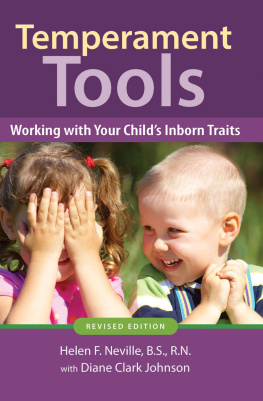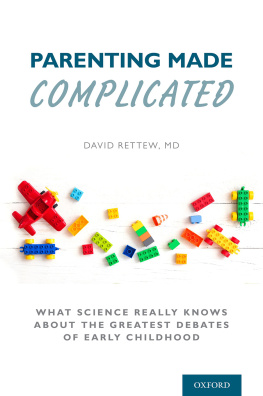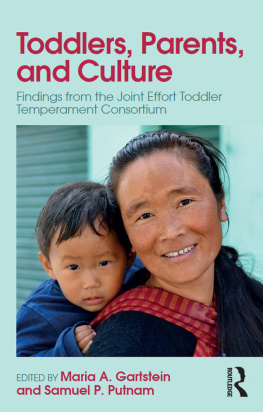
Parenting by Temperament
Full Revised Edition
by
Nancy Harkey, Ph.D.
and
Teri Jourgensen, MPA
2012 Nancy J. Harkey and Teri L. Jourgensen
All rights reserved.
No part of this book may be reproduced, stored in a retrieval system, or transmitted by any means without the written permission of the authors.
First published by CreateSpace, March, 2009
P rint edition (Parenting by Temperament : The New Revised Edition of Raising CuddleBugs and BraveHearts) is available at Amazon.com
Full Revised Edi tion published June, 2012
This book is dedicated to Erik and Peter, who taught us how delightfully different two brothers could be.
Acknowledgments
This book had its origin in the development of our Childhood Temperament Sorters, and this could not have happened without help from the faculty and students in the Psychology and Sociology Department at California State Polytechnic University, Pomona. Those efforts went far beyond the call of both duty and collegiality. We will be forever grateful to Marcia Lasswell, Susan Siaw, Laurie Roades, Ruth-Ellen Grimes, James Sturges, Scott Roesch, Larry Goldman, Lou King, Miranda Barone, Ann Englert, Cynthia Teeple, and Bonnie Thorne for heroic efforts in helping with data collection. And to the hundreds of students who found families for uswe cant name you all, but you have our undying gratitude. A small piece of the work of each of you is now embodied in our Childhood Temperament Sorters. We also wish to thank Barbara Way, Dean of the College of Arts, Letters and Social Sciences, as well as Cal Poly University for the financial support that made our data collection possible.
Our most personal thanks must go to all the members of our immediate families, for their continuing support and encouragement and for the wonderful temperament examples that they have given useach and every one! Thanks to Lorle, Michael, Scott, Candace, Kevin, Sean, Dylan, Travis, Meghan, Erik, and Peter, and all the extended family and friends that brighten their lives and ours.
Ta b le of Contents
Part I: The Basic Design for Success
Part II: The idea of preferences and the Measurement of Preferences
Part III: The Four Major Preference Pairs
Part IV: The Cr i tically I m portant Temperaments
Part V: Polishing the Basic DesignIntegrating Responsiveness, Demandingness and Temperament
Ove r v iew
Part VI : Adding Grace to Your Parenting DesignWorking with Your Childs Temperament
Conclusion: The Happy Family
About the Book, Authors, Websites
Our Three Guiding Principles
First of all
No child comes into the world as a blank slate. Nature provides every child with inborn plans for growth and development. Most essential are the needs for closeness, safety and comfort on the one hand, and the needs for exploration and independence on the other hand.
And therefore---
The primary job of a good parent is to help the child to develop both love and community with others, and a strong and independent self. Because this is true for all parents and all children, it is possible to describe an ideal general model for warm, but wise love, and firm but thoughtful discipline that applies to every family.
Secondly:
Every child also differs from every other child in unique and important ways. Like adults, children differ in the things they find most interesting in the world, in the way they resolve problems and structure their time, and in their preferences for high levels of excitement or greater calmness and serenity. Even the balance of closeness seeking and self-assertion will differ innately from child to child.
And therefore---
Although you canand should-- guide your childs natural desires in positive ways, you do not create them. They have their own developmental plan that unfolds as they grow. One of your most important tasks here is to lovingly parent the child you have been given, and not some other child of your imagination
And Finally:
Just as every child is unique, it follows logically that this is equally true of every parent. Along with a lifetime of experience, you bring to the task of parenting your own innate strengths and weaknesses, delights and aversions.
Some parents love excitement and change; others crave order and predictability. Some parents are gifted at nurture and tenderness; others are more gifted at analyzing problems and finding practical solutions. Some relish the moment; others always take the long view toward the future. Some love to be surrounded by people and action; others love peace and quiet and one-on-one relationships.
For all these reasons, individual parents will naturally approach parenting differently.
And therefore:
A good parenting plan not only has to be adapted to fit the real child being parented, it also needs some adjustment in order to fit the real parent. Sometimes this means some changes in the plan, and sometimes it means some changes in the parentsome stretching or tweaking of your natural style in the direction of the ideal plan. Self-knowledge on the parents part is essential to this.
Part I: The Basic Design for Success:
Responsiveness and Demandingness
In a Powerful Blend
What is Responsiveness?
We use this word, with gratitude to Diana Baumrind , to mean tender love and caring, but also something more. That something more is the sum total of several things. One is the effort spent to really get to know your childwhat is exciting for him, what is not; what is motivating for her, what is not; what is easy, what is hard. We all learn a part of this over time, but the responsive parent does this more purposefully.
Interacting frequently with your child to share feelings, stories and ideas, and to communicate clearly about values, and family rules is another example. Even maintaining a warm and predictable home environment is a part of this.
What is demandingness?
This includes everything you normally think of as discipline, but again with something more. It implies standards and expectations that have been well thought out in advance, and consequences for misbehavior that are also well-planned. Most of all it includes the concept that discipline is a form of teaching, a gift from a good parent to a growing child.
How does the nature of human nature suggest this powerful blend?
This is the first question we discuss in this book and it is critically important . To envision an effective blend of love and disciplineresponsiveness and demandingness--you need a clear vision of the qualities your child brings into the world.
Chapter 1: What All Children Bring Into the World and What This Means About Parenting
Who is your child, really?
This is probably the most important thing that you have to know in order to think wisely about this childs development, and your critically important role in that.
First of allwhere does human nature come from? Experts differ!
Philosophers, psychologists and parenting experts have given us many versions of the nature of the child over the years. If you had been a young parent in the early 1800s you might have been warned that children often brought native depravity into the world with them, and were also in danger of Satanic influence. In such a case it would be easy to imagine the role of parentsto chase the devil of them! You are not likely to encounter this extreme view of the newborn child today, although there may be a remnant of that in experts who put most of their emphasis on discipline.
Next page








